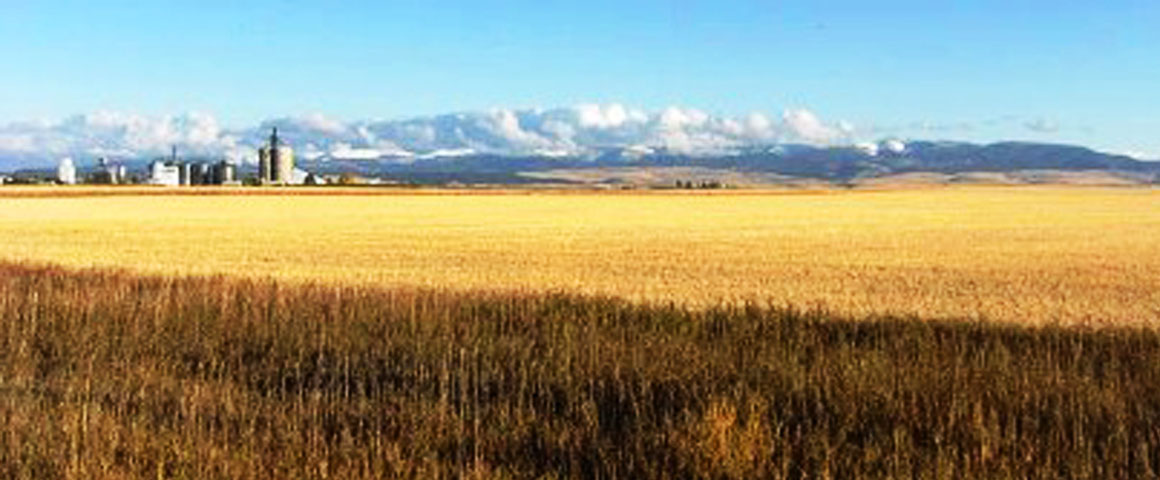Judith River Watershed Nitrogen Project
Water from many private wells in Judith Basin and Fergus counties have nitrate concentrations
greater than 10 ppm which is a level that can pose health risks. In addition to health
concerns, nitrogen lost to groundwater from agricultural soils means lost fertilizer
and/or soil organic nitrogen which can hurt yield and protein and cause economic losses
to farmers.
The Judith River Watershed Nitrogen Project (JRWNP) is a research project funded by
the USDA National Institute of Food and Agriculture (NIFA; grant # 2011-51130-31121)
to explore sources of nitrogen in ground and surface water in the Judith River Watershed
(JRW) of central Montana. This work began in fall 2011 with researchers and Extension
specialists from Montana State University and Utah State University partnering with
producers in Judith Basin and Fergus counties to design a research project to address
the following three goals:
Goal 1: To better understand the sources of nitrate in ground and surface water.
Goal 2: To evaluate which agricultural management practices are likely to be effective at reducing nitrate leaching and are also likely to be adopted and maintained.
Goal 3: To engage the local community to ensure that the research is relevant and useful.
The research team has worked closely with six farmers on the Producer Research Advisory Group (PRAG) and with 14 members of an Advisory Committee (AC) to design this project. Research has included evaluation of different farming management practices on cooperating farmers’ fields and collection of water samples from wells, springs and streams across the watershed. The majority of field sample collection for the project was completed by fall 2014 and the final data analysis phase is underway.
A series of newsletters has been released in 2014 and 2015, which can be found below. You can also view the Handouts from the 2015 field day.
Project Newsletters
- Newsletter 1: Project Overview & Highlights from 2014 Field Day
- Newsletter 2: Process and Timing of Nitrate Leaching
- Newsletter 3: How Do Alternative Management Practices Affect Nitrate Leaching and Net Profit?
- Newsletter 4: Sources of Nitrate in Shallow Groundwater
Project Team
Research Results
-
Sigler, W.A., Ewing, S.A., Wankel, S.D., Jones, C.A., Leuthold, S., Brookshire, E.N.J., Payn, R.A., 2022. Isotopic signals in an agricultural watershed suggest denitrification is locally intensive in riparian areas but extensive in upland soils. Biogeochemistry. https://doi.org/10.1007/s10533-022-00898-9
- Sigler, W.A., Ewing, S.A., Jones, C.A., Payn, R.A., Miller, P., Maneta, M., 2020. Water and nitrate loss from dryland agricultural soils is controlled by management, soils, and weather.J. Agriculture, Ecosystems & Environment. 304, 1-14. https://www.sciencedirect.com/science/article/pii/S0167880920303443
-
Sigler, W. A. (2020). Water quality response to water and nitrogen movement through a semi-arid dryland agroecosystem in Montana, USA (Order No. 27958981). Available from Dissertations & Theses @ Montana State University; ProQuest Dissertations & Theses Global. (2403046433). Retrieved fromhttps://search-proquest-com.proxybz.lib.montana.edu/docview/2403046433?accountid=28148
-
Jackson-Smith D, Ewing S A, Jones. C A, Sigler W A and Armstrong A, 2018. The road less travelled: Assessing the impacts of in-depth farmer and stakeholder participation in groundwater nitrate pollution research. J. Soil Water Conserv. 73, 610-622.
-
Sigler, W.A., Ewing, S.A., Jones, C.A., Payn, R.A., Brookshire, E.N.J., Klassen, J.K., Jackson-Smith, D., Weissmann, G.S., 2018. Connections among soil, ground, and surface water chemistries characterize nitrogen loss from an agricultural landscape in the upper Missouri River Basin. J. Hydrol. 556, 247–261. (MSU Library Open Source Version)
-
John, A.A., Jones, C.A., Ewing, S.A., Sigler, W.A., Bekkerman, A., Miller, P.R., 2017. Fallow replacement and alternative nitrogen management for reducing nitrate leaching in a semiarid region. Nutr. Cycl. Agroecosystems 1–18. (MSU Library Open Source Version)
-
John, A.A., 2015. Fallow Replacement and Alternative Fertilizer Practices: Effects on Nitrate Leaching, Grain Yield and Protein, and Net Revenue in a Semiarid Region (MS Thesis). Montana State University. (online here)
-
Miller, C., 2013. Groundwater Nitrate Transport and Residence Time In A Vulnerable Aquifer Under Dryland Cereal Production (MS Thesis). (online here)
Producer Survey Results
- Judith Basin Nitrogen Project 2012 Farmer Survey - Summary Report
- Judith Basin Nitrogen Project 2015 Farmer Survey - Summary Report
Press Releases
- Landowner Survey to Help Guide Research on Nitrogen Movement and Management in the Judith River Basin
- Judith Basin Nitrogen Project Overview
- Fallow Replacement Shows Promise for Improved Drinking Water Quality
- Fallow Replacement Can Improve Bottom Line and Benefit Water Quality
Related Resources
W. Adam Sigler PhD Dissertation Defense
"Water and nitrogen movement through a semiarid dryland agroecosystem in central Montana"
March 6th, 2020

